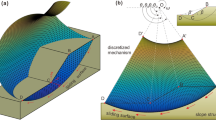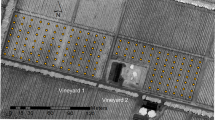Abstract
Contour ridge systems may lead to seepage that could result in serious soil erosion. Modeling soil erosion under seepage conditions in a contour ridge system has been overlooked in most current soil erosion models. To address the importance of seepage in soil erosion modeling, a total of 23 treatments with 3 factors, row grade, field slope and ridge height, in 5 gradients were arranged in an orthogonal rotatable central composite design. The second-order polynomial regression model for predicting the sediment yield was improved by using the measured or predicted seepage discharge as an input factor, which increased the coefficient of determination (R2) from 0.743 to 0.915 or 0.893. The improved regression models combined with the measured seepage discharge had a lower P (0.007) compared to those combined with the predicted seepage discharge (P=0.016). With the measured seepage discharge incorporated, some significant (P<0.050) effects and interactions of influential factors on sediment yield were detected, including the row grade and its interactions with the field slope, ridge height and seepage discharge, the quadratic terms of the field slope and its interactions with the row grade and seepage discharge. In the regression model with the predicted seepage discharge as an influencing factor, only the interaction between row grade and seepage discharge significantly affected the sediment yield. The regression model incorporated with predicted seepage discharge may be expressed simply and can be used effectively when measured seepage discharge data are not available.
Similar content being viewed by others
References
Brunner A C, Park S J, Ruecker G R, et al. 2008. Erosion modelling approach to simulate the effect of land management options on soil loss by considering catenary soil development and farmers perception. Land Degradation & Development, 19(6): 623–635.
Changere A, Lal R. 1995. Soil degradation by erosion of a typic hapludalf in central Ohio and its rehabilitation. Land Degradation & Development, 6(4): 223–238.
Chu-Agor M L, Fox G A, Cancienne R M, et al. 2008. Seepage caused tension failures and erosion undercutting of hillslopes. Journal of Hydrology, 359(3–4): 247–259.
Cui M, Cai Q G, Zhang Y G, et al. 2007. Development of ephemeral gully during rainy season in the slope land in rolling-hill black-soil region of Northeast China. Transactions of the CSAE, 23(8): 59–65. (in Chinese)
Ding X Q. 1986. The Applied Regression Design of the Field Experiment. Changchun: Ji Lin Agriculture Science Press, 89–95. (in Chinese).
Domínguez J R, González T, Palo P, et al. 2010. Anodic oxidation of ketoprofen on boron-doped diamond (BDD) electrodes. Role of operative parameters. Chemical Engineering Journal, 162(3): 1012–1018.
Fang N F, Shi Z H, Li L, et al. 2012. The effects of rainfall regimes and land use changes on runoff and soil loss in a small mountainous watershed. Catena, 99: 1–8.
Flanagan D C, Livingston S J. 1995. Water erosion prediction project (WEPP) user summary. In: USDA-ARS National Soil Erosion Research Laboratory. NSERL report No. 11. West Lafayette, IN, USA.
Fohrer N, Berkenhagen J, Hecker J M, et al. 1999. Changing soil and surface conditions during rainfall: single rainstorm/subsequent rainstorms. Catena, 37(3–4): 355–375.
Fox G A, Wilson G V, Simon A, et al. 2007. Measuring streambank erosion due to ground water seepage: correlation to bank pore water pressure, precipitation and stream stage. Earth Surface Processes and Landforms, 32(10): 1558–1573.
Fox G A, Wilson, G V. 2010. The role of subsurface flow in hillslope and stream bank erosion. A review. Soil Science Society of America Journal, 74(3): 717–733.
Gebreegziabher T, Nyssen J, Govaerts B, et al. 2009. Contour furrows for in situ soil and water conservation, Tigray, Northern Ethiopia. Soil & Tillage Research, 103(2): 257–264.
Griffith D R, Parsons S D, Mannering J V. 1990. Mechanics and adaptability of ridge-planting for corn and soya bean. Soil & Tillage Research, 18(2–3): 113–126.
Grum B, Assefa D, Hessel R, et al. 2017. Effect of in situ water harvesting techniques on soil and nutrient losses in semi-arid northern Ethiopia. Land Degradation & Development, 28(3): 1016–1027.
Hadjmohammadi M, Sharifi V. 2012. Simultaneous optimization of the resolution and analysis time of flavonoids in reverse phase liquid chromatography using Derringer's desirability function. Journal of Chromatography B, 880: 34–41.
Hessel R, Messing I, Liding C, et al. 2003. Soil erosion simulations of land use scenarios for a small Loess Plateau catchment. Catena, 54(1–2): 289–302.
Huang C H, Laften J M. 1996. Seepage and soil erosion for a clay loam soil. Soil Science Society of America Journal, 60(2): 408–416.
Huang C H. 1998. Sediment regimes under different slope and surface hydrologic conditions. Soil Science Society of America Journal, 62(2): 423–430.
Knapen A, Poesen J, Govers G, et al. 2007. Resistance of soils to concentrated flow erosion. A review. Earth-Science Reviews, 80(1–2): 75–109.
Lal R. 1990. Ridge-tillage. Soil & Tillage Research, 18(2–3): 107–111.
Legates D R, McCabe G J. 1999. Evaluating the use of "goodness-of-fit" measures in hydrologic and hydroclimatic model validation. Water Resources Research, 35(1): 233–241.
Liu H, Lei T W, Zhao J, et al. 2011. Effects of rainfall intensity and antecedent soil water content on soil infiltrability under rainfall conditions using the run off-on-out method. Journal of Hydrology, 396(1–2): 24–32.
Liu L, Liu Q J, Yu X X. 2016. The influences of row grade, ridge height and field slope on the seepage hydraulics of row sideslopes in contour ridge systems. Catena, 147: 686–694.
Liu Q J, Shi Z H, Yu X X, et al. 2014a. Influence of microtopography, ridge geometry and rainfall intensity on soil erosion induced by contouring failure. Soil & Tillage Research, 136: 1–8.
Liu Q J, Zhang H Y, An J, et al. 2014b. Soil erosion processes on row sideslopes within contour ridging systems. Catena, 115: 11–18.
Liu Q J, An J, Wang L Z, et al. 2015. Influence of ridge height, row grade, and field slope on soil erosion in contour ridging systems under seepage conditions. Soil and Tillage Research, 147: 50–59.
Liu Q J, An J, Zhang G H, et al. 2016. The effect of row grade and length on soil erosion from concentrated flow in furrows of contouring ridge systems. Soil and Tillage Research, 160: 92–100.
Nachshon U. 2016. Seepage weathering impacts on erosivity of arid stream banks: A new conceptual model. Geomorphology, 261: 212–221.
Ni L S, Fang N F, Shi Z H, et al. 2017. Validating a basic assumption of using cesium-137 method to assess soil loss in a small agricultural catchment. Land Degradation & Development, 28(5): 1772–1778.
Nishigaki T, Sugihara S, Kilasara M, et al. 2017. Surface runoff generation and soil loss under different soil and rainfall properties in the Uluguru Mountains, Tanzania. Land Degradation & Development, 28(1): 283–293.
Nouwakpo S K, Huang C H, Bowling L, et al. 2010. Impact of vertical hydraulic gradient on rill erodibility and critical shear stress. Soil Science Society of America Journal, 74(6): 1914–1921.
Nouwakpo S K, Huang C H. 2012. The role of subsurface hydrology in soil erosion and channel network development on a laboratory hillslope. Soil Science Society of America Journal, 76(4): 1197–1211.
Quinton J N, Catt J A. 2004. The effects of minimal tillage and contour cultivation on surface runoff, soil loss and crop yield in the long-term Woburn Erosion Reference Experiment on sandy soil at Woburn, England. Soil Use and Management, 20(3): 343–349.
Razafison U, Cordier S, Delestre O, et al. 2012. A shallow water model for the numerical simulation of overland flow on surfaces with ridges and furrows. European Journal of Mechanics B/Fluids, 31: 44–52.
Regmi R K, Jung K, Nakagawa H, et al. 2017. Numerical analysis of multiple slope failure due to rainfall: Based on laboratory experiments. Catena, 150: 173–191.
Sato M, Kuwano R. 2015. Suffusion and clogging by one-dimensional seepage tests on cohesive soil. Soils and Foundations, 55(6): 1427–1440.
Shi Z H, Cai C F, Ding S W, et al. 2004. Soil conservation planning at the small watershed level using RUSLE with GIS: a case study in the Three Gorge Area of China. Catena, 55(1): 33–48.
Shi Z H, Chen L D, Fang N F, et al. 2009. Research on the SCS-CN initial abstraction ratio using rainfall-runoff event analysis in the Three Gorges Area, China. Catena, 77(1): 1–7.
Shi Z H, Ai L, Li X Y, et al. 2013. Partial least-squares regression for linking land-cover patterns to soil erosion and sediment yield in watersheds. Journal of Hydrology, 498: 165–176.
St-Pierre N R, Weiss W P. 2009. Technical note: Designing and analyzing quantitative factorial experiments. Journal of Dairy Science, 92(9): 4581–4588.
Tang Q Y. 2010. DPS Data Processing System-Experimental Design, Statistical Analysis and Data Mining (2nd ed.). Beijing: Science Press, 258–269. (in Chinese)
USDA-ARS ( U S Department of Agriculture–Agriculture Research Service ). 2008a. User's reference guide, Revised Universal Soil Loss Equation Version 2. [2013-03-01]. http://www.ars.usda.gov/sp2UserFiles/Place/64080510/RUSLE/RUSLE2_User_Ref_Guide.pdf.USDA-ARS. 2008b. Draft science documentation, Revised Universal Soil Loss Equation Version 2. [2013-03-01]. http://www.ars.usda.gov/sp2UserFiles/Place/64080510/RUSLE/RUSLE2_Science_Doc.pdf.
Valentin C, Poesen J, Li Y. 2005. Gully erosion: Impacts, factors and control. Catena, 63(2–3): 132–153.
Wilson G V, Periketi R K, Fox G A, et al. 2007. Soil properties controlling seepage erosion contributions to streambank failure. Earth Surface Processes and Landforms, 32(3): 447–459.
Wiyo K A, Kasomekera Z M, Feyen J. 1999. Variability in ridge and furrow size and shape and maize population density on small subsistence farms in Malawi. Soil & Tillage Research, 51(1–2): 113–119.
Yan B, Fang N, Zhang P, et al. 2013. Impacts of land use change on watershed streamflow and sediment yield: An assessment using hydrologic modelling and partial least squares regression. Journal of Hydrology, 484: 26–37.
Yan F L, Shi Z H, Li Z X, et al. 2008. Estimating interrill soil erosion from aggregate stability of Ultisols in subtropical China. Soil & Tillage Research, 100(1): 34–41.
Zheng F L, Huang C H, Norton L D. 2000. Vertical hydraulic gradient and run-on water and sediment effects on erosion processes and sediment regimes. Soil Science Society of America Journal, 64(1): 4–11.
Ziegler A D, Giambelluca T W, Plondke D, et al. 2007. Hydrological consequences of landscape fragmentation in mountainous northern Vietnam: Buffering of Hortonian overland flow. Journal of Hydrology, 337(1–2): 52–67.
Acknowledgements
This study was funded by the National Natural Science Foundation of China (41701311), the Natural Science Foundation of Shandong Province (ZR2017JL019), the Project of Introducing and Cultivating Young Talent in the Universities of Shandong Province (LUJIAORENZI20199) and the Shandong Key Research and Development Program (2018GSF117001).
Author information
Authors and Affiliations
Corresponding author
Rights and permissions
About this article
Cite this article
Liu, Q., Ma, L. & Zhang, H. Applying seepage modeling to improve sediment yield predictions in contour ridge systems. J. Arid Land 12, 676–689 (2020). https://doi.org/10.1007/s40333-020-0094-6
Received:
Revised:
Accepted:
Published:
Issue Date:
DOI: https://doi.org/10.1007/s40333-020-0094-6




